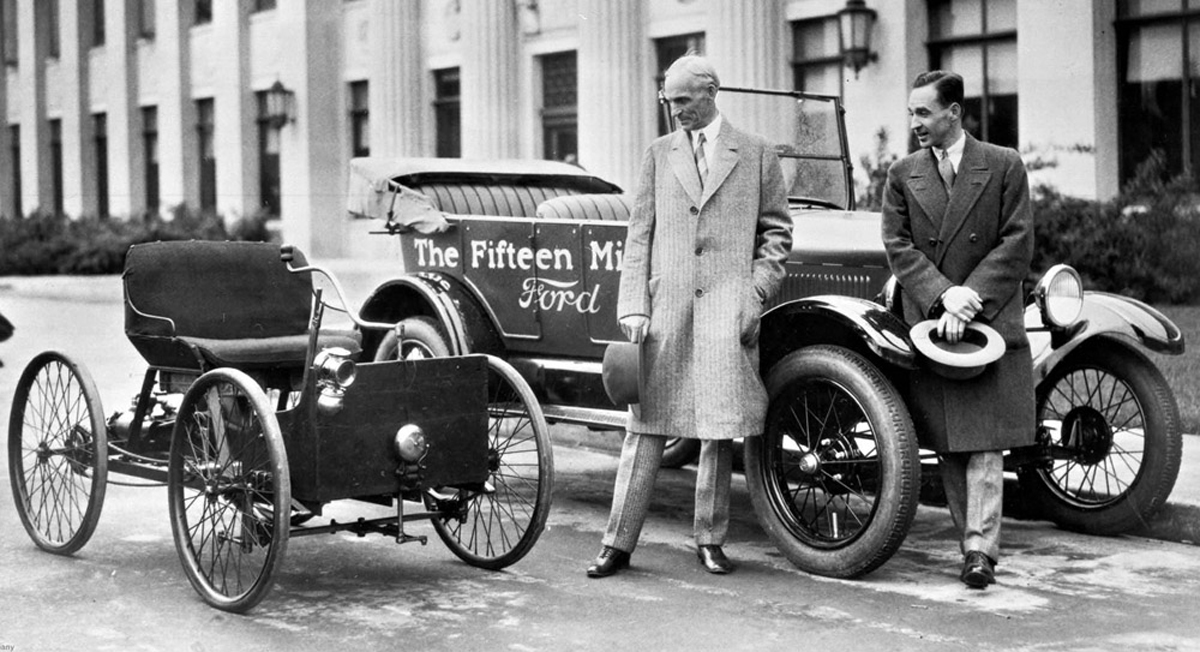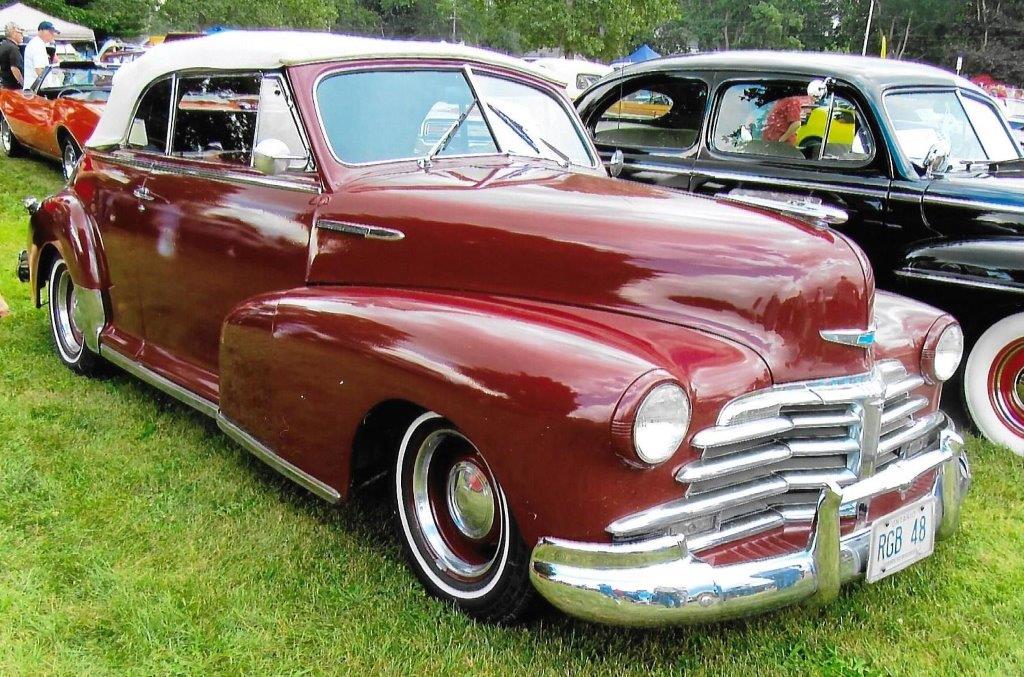
Edsel Ford – Made In Detroit – Peter Epp
It was against Henry Ford II’s better judgment in 1955 that he allowed a committee of Ford executives to choose his father’s name to promote an entirely new division of Ford-built vehicles.
But the men at the Ford Motor Company were so confident that the new division would achieve all of their financial and manufacturing objectives that they deemed it the highest honour to name it after Edsel Bryant Ford.
Henry Ford II, Edsel’s eldest child and the president of Ford, was at first against the idea but grudgingly relented. Yet after the new Edsel was introduced and then quickly bombed in the marketplace, Henry Ford II rued the day he had allowed the name of his beloved father to become synonymous with such a public failure.
Edsel Ford deserved better, much better. The only child of the first Henry Ford and his wife, the former Clara Bryant, Edsel was the heir to one of the largest manufacturing concerns on the planet.
But he was also a sensitive, artistic man who loved automobiles and who had pushed his father, mostly without success, to improve the cars built by the Ford Motor Company.
For most of his life, Edsel was overshadowed by his father’s staggering success and by Old Henry’s frequently obsessive personality. Edsel’s influence on the company was therefore stifled and his potential as an auto executive and leader among Detroit’s most influential men was never fully realized.
Tragically, his life was cut short at age 49. Edsel Ford died in May 1943 from cancer. His dominant father out-lived him by four years; his sympathetic mother by seven.
Edsel wasn’t born into wealth or privilege. His parents had been married for five years by the time Edsel was born in Detroit in 1893. Henry Ford, however, was already well-known in the tight-knit fraternity of engineers and manufacturing men of the city. When Edsel was not yet three years old, Henry developed his first automobile, building the contraption in a tiny garage beside the modest house shared with his wife and their little boy.
By the time Edsel was 20, in 1913, his father was arguably the most important non-political person in the United States, and certainly on his way to becoming the wealthiest American. The Ford Motor Company that year was just hitting is stride, building more than half the cars sold in the U.S., and its chief shareholder, Henry Ford, was contemplating even greater things. And he wanted Edsel to be part of that.
But there always existed within Henry an ambivalent regard for his only child. He truly loved Edsel, yet harboured a consuming jealousy whose bitterness had the capacity to poison his relationship with whom he interacted, including his son. It was as if Henry couldn’t stand to share any of the considerable glory that shone on the Ford Motor Company, not even with his own flesh and blood and the heir to the company.
By the time Edsel was 26, in 1919, Henry had succeeded in buying out all of the non-family held shares in the Ford Motor Company. He made Edsel company president but remained the real power, over-riding Edsel’s suggestions and concern for the company’s future.
Most of the conflict swirled around the Model T, which since its inception in 1908 had become an incredible success. But Henry was loath to make an improvement to the Model T, surmising that the original design was perfect. To remain competitive within the marketplace, he lowered the sale price of the car, sometimes several times a year. Yet Henry found that the more he lowered the price, the more cars he sold. Thus, his genius continued to be validated.
By the early 1920s, cars such as General Motors’ Chevrolet were starting to gain popularity because of technical innovations and modern styling, and it was Edsel who pleaded with his father to make changes to the Model T.
Henry wouldn’t budge, and indeed viewed it as treason that his son and other Ford executives would even suggest that his car needed improvement. Henry Ford must have viewed the Model T as an extension of his own existence and personality, for suggestions of improvement to the car were thought to be assaults on his personal being. He not only loved the car but also the industrial process that brought the vehicle to existence, and both were sacred.
There is a telling story of the time when Henry travelled to Europe on business and upon his return was led into a back room at one of the Ford factories where a beaming Edsel unveiled a Model T prototype that had been secreted updated and improved. Henry walked closely around the car, grabbed a nearby axe and in a fury started to hack the car apart.
It wasn’t until August 1926 that the old man finally relented and plans were made for a new car, the Model A. The final Model T was assembled in May 1927, and for the next six months Ford factories lay quiet as they were retooled to prepare for the launch of the new vehicle – the first new Ford car within a generation.
Edsel had a huge role in the Model A’s development, advocating for refinements and improvements. The styling was left to him alone. The Model A was an enormous hit, selling four million units within four years.
Henry had initially allowed Edsel to fulfill his passion for automobile design when the Ford Motor Company purchased the Lincoln Motor Car Company in 1922 for $8 million. Edsel was left mostly alone to make crucial engineering and styling decisions for Lincoln, and while never a profitable division, Lincoln’s progress was steady and its public profile was quietly elevated over the years.
In the 1930s, Edsel’s styling influence was further explored within the Lincoln brand. He alone deserves credit for the handsome Lincoln Zephyr, for his own personal automobile that became the template for the classic Lincoln Continental, and for the launch and development of Mercury in the late 1930s.
Zephyr was introduced as an inexpensive Lincoln to better compete for those few dollars within the Depression-era marketplace that were being set upon by the likes of Cadillac and Packard, both which had cheaper variations of their automobiles, the LaSalle and the Packard 120. LaSalle never sold well, but continued to be the style leader within the General Motors family. The 120 turned out to be a phenomenal seller for Packard, whose portfolio was entirely devoted to luxury car and therefore to an extremely limited market.
The Zephyr was streamlined and featured a boat-like prow for its grille that was far more attractive than the streamlined Airflow cars that Chrysler had introduced for 1934 for its Chrysler and DeSoto divisions. Zephyr was also lighter than most cars and featured a V12 engine that was engineered to fit into its narrow engine bay.
The car was a stunning hit for Ford and a personal achievement for Edsel Ford.
Another personal achievement for Edsel was his family. He had married Eleanor Clay in 1915 (she was a niece to J.L. Hudson, founder of Detroit’s premier department store and the principal investor for a car company that bore his name Hudson. So popular was the Hudson brand in the early 1920s that was the third most popular nameplate in America). Their eldest child was Henry Ford II (1917-1987) Their second child was Benson Ford (1919-1978). Their only daughter was Josephine Clay Ford (1923-2005). Their youngest child was William Clay Ford (1925-2014), a retired executive with the Ford Motor Company and the long-time owner of the Detroit Lions.
Eleanor Ford always blamed her father-in-law for her husband’s death. With the pressure of the company almost entirely on his shoulders, but with little support from his father, Edsel had developed health problems while in his 40s, including an ulcer. Eventually, he was overcome with stomach cancer yet continued with the company.
Henry was 79 years old when Edsel died and his mind wasn’t as sharp as it once had been. But he had never invested confidence into his son’s abilities, and whatever confidence was permitted was always grudgingly extended. Perversely, Henry had lent highly visible support to some unsavoury characters within the Ford Motor Company, and together they had allowed the company to be horribly mismanaged. Edsel knew this, and was compelled to deal with the fallout, but was unable to break his father’s hold on Ford. In the end, it was Edsel’s health that broke.
Edsel Ford’s death created an immediate crisis of the highest magnitude. Large and immense were the problems within the Ford Motor Company that the U.S. government – which was counting on Ford to fulfil crucial military contracts for the war effort – feared that a company collapse could sink America’s industrial front against the Axis powers.
The Roosevelt Administration therefore called upon Henry Ford II, who was in the Navy, to return to civilian life and join the company’s management. Three years later, Young Henry was named president of the Ford Motor Company, although Old Henry initially, and naturally, didn’t want that.
It was Eleanor who put her foot down and told her father-in-law that if her eldest son wasn’t permitted to lead the company and assume a role that had been denied her long-suffering husband, she would sell the shares she had inherited from Edsel.
Clara Ford agreed with her widowed daughter-in-law and told her husband that she would leave him if he didn’t submit to their wishes. The old man did. He died less than two years later.
The story of Edsel Ford is rather tragic. In his own right, Edsel was brilliantly talented and, in fact, held in high esteem by members of Detroit’s ruling class. Had he been allowed to take over the reigns of the Ford Motor Company in the 1930s, perhaps upon the permanent “retirement” of his father in 1933 at age 70, it’s highly unlikely that the company would have drifted into the financial shambles it had become in 1943.
It was once said that James Couzens, the Chatham, Ontario-born man who had helped organize the Ford Motor Company in 1903, and who had become a major shareholder and then had a huge falling out with Henry Ford, once told Ford that he didn’t envy him for anything – “except for your son.”
But any success that was accorded to Edsel was always, and will always be, overshadowed by the brilliant genius that consumed Henry Ford and eventually consumed his only son.




